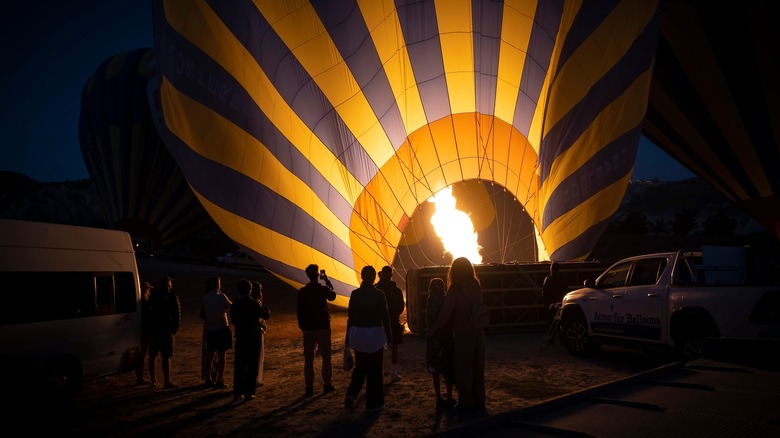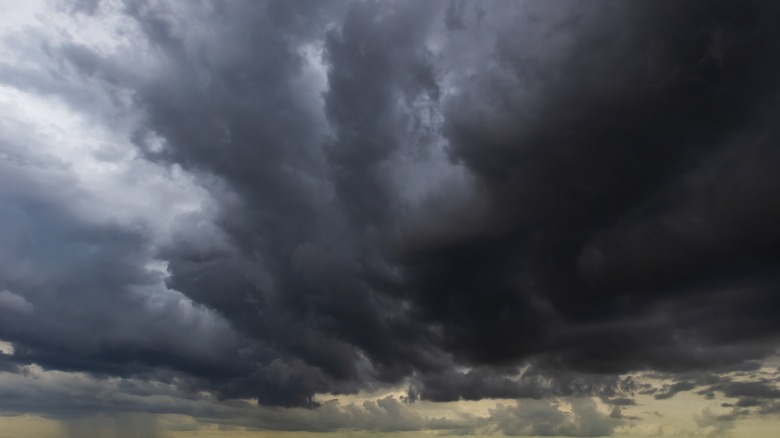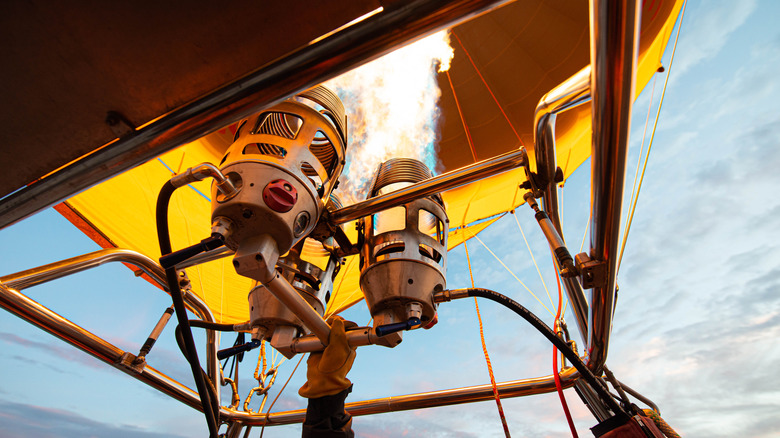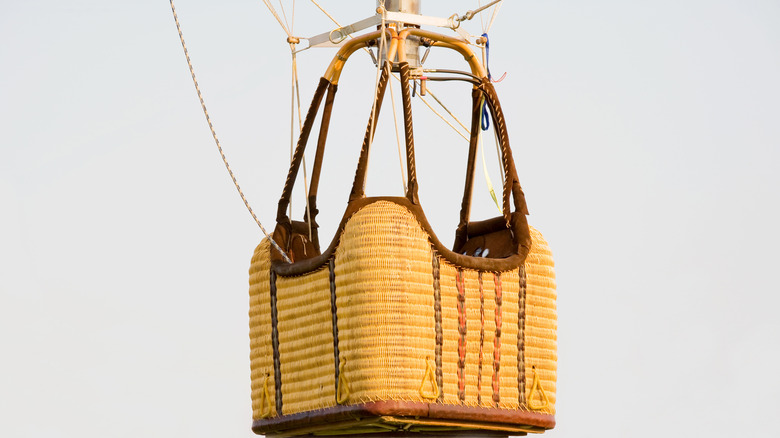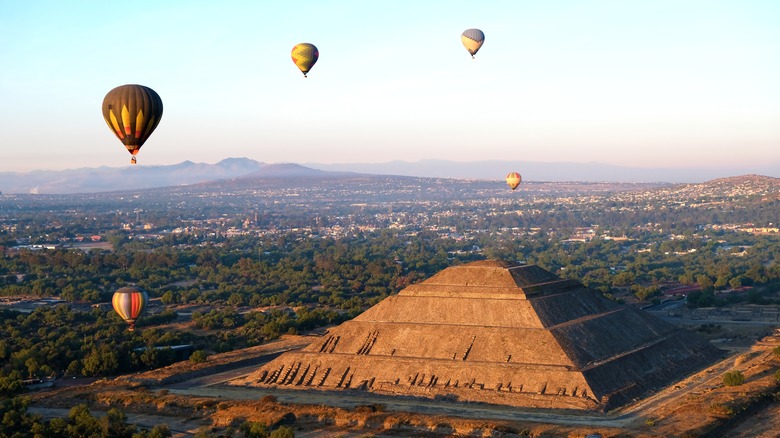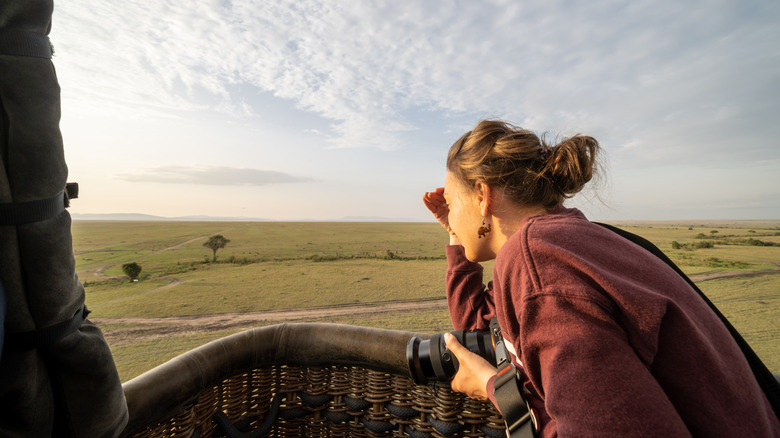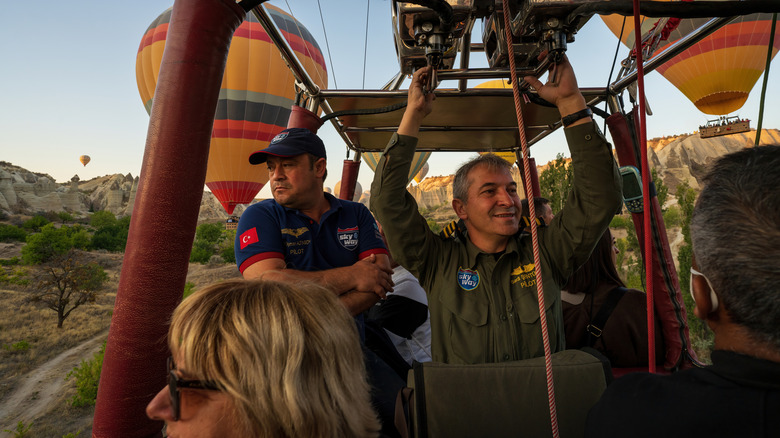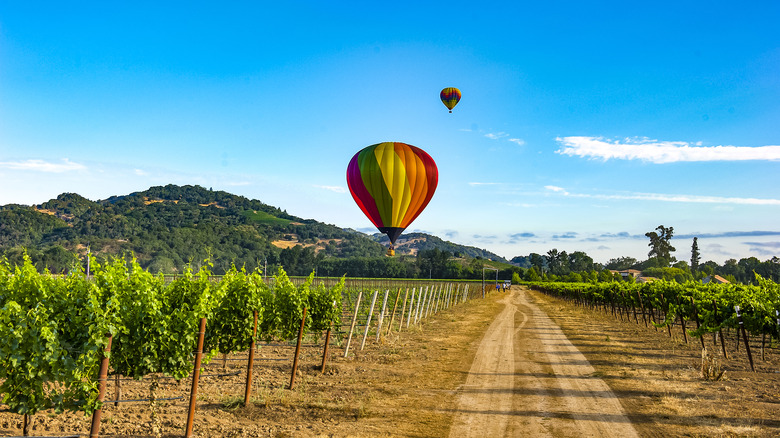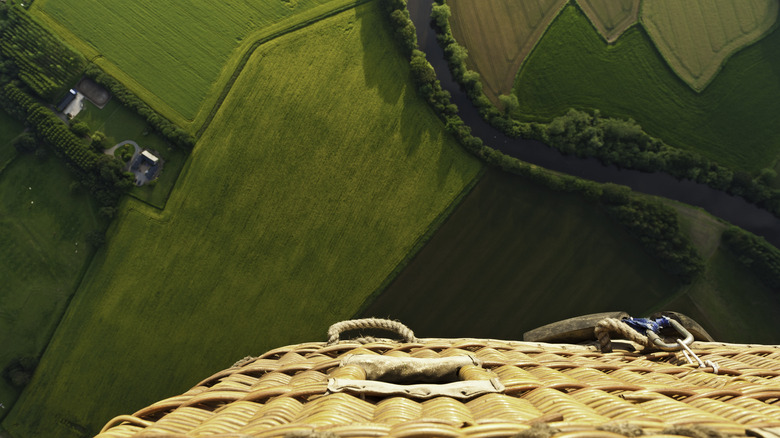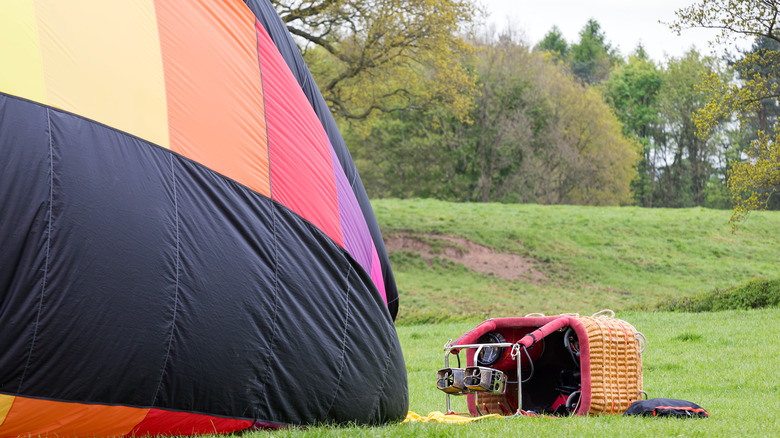What To Expect When You Book A Hot-Air Balloon Ride
A bucket-list adventure that will last in the memory long after it's over, a hot-air balloon ride allows travelers to see the landscape from a truly unusual vantage point. This method of slow air travel is directed by the vagaries of the wind, ceding control to the elements. There is something refreshingly liberating about a balloon ride, from the rudimentary set-up to the unknown nature of the route. Passenger balloons have a history dating to the 1700s when a pair of French brothers began tinkering with prototypes.
Since then, balloons have developed in strides and grown as a part of everyday life, from vehicles used for tourism exploration to vessels that have embarked on feats of derring-do via flights around the globe. From the ground, balloons exude the trappings of a carefree existence, and they instill a feeling of wanderlust in onlookers. But for travelers who have never taken a balloon ride, there are a lot of factors to consider before embarking on a maiden voyage, some obvious, others not so readily apparent.
The cost
Balloon rides aren't an activity that friends, families, or groups do regularly — because they are not cheap. Rides usually cost between $150 and $400 per person, typically lasting an hour minimum, package-dependent. This might seem exorbitant, but a number of factors contribute to the sticker shock. For starters, balloons need to be meticulously maintained since one that fails in mid-air could put the riders in a life-or-death situation. Balloons are very expensive, and a large one can cost the same as a luxury sports car, even though their technology has changed little in centuries.
Balloons can't always fly year-round since they depend on prevailing weather conditions, so operators must defray their costs across a limited season. Commercial balloon companies make their money by taking passengers up for a ride, so they need to buy the relevant insurance, and, as we all know, insurance is rarely cheap. Finally, tack on the fuel costs, payments to employees — and this isn't just the pilot, but also support staff — and the charges for storing the equipment when it's not in use, and the numbers add up. For passengers, the above price is a starting point. If you opt for a special package, like adding a Champagne toast or booking a ride to make an engagement proposal, expect the prices to head north.
The timetable
You might wonder why you don't see balloons floating in the sky in the middle of the day when the ambient temperature is often nearing its peak. This is because the best conditions, for flying at least, are around dawn and dusk, and science offers a logical explanation. A balloon's flying ability is relatively straightforward to demystify — heat the air in the canopy, and since hot air rises, the balloon will float upwards. When the temperature outside is the coldest, usually during dawn and dusk (pilots need light to see, so balloons don't fly at night), it becomes easier to heat the air inside the balloon and make it hotter than the surrounding air.
During the middle of the day, the heated air has to work harder to overcome the higher ambient temperatures, possibly leading to overheating. In the summer, night and daytime temperatures vary markedly, and overheating becomes a real concern. Furthermore, the conditions are also more pleasant at dawn and dusk in the summer; they are cooler and have cleaner light that produces an epic sunrise or sunset. Bear in mind that even for a flight at 7 a.m., passengers are expected to be at the launch zone well before that for preparation, safety briefings, signing of waivers, and so on. So, if you aren't a morning person, think about the evening flight; otherwise, you'll need to set the alarm clock for an early wake-up call.
The restrictions
Unlike commercial airlines, a balloon's ability to take the sky depends on the weather. While that is partially true for any aircraft — a flight might be grounded if a hurricane or powerful thunderstorm, for instance — it doesn't wholly dictate whether a plane can take off. Airlines can continue to operate where there is heavy rain, bouts of snow, periods of strong winds, and more since their aircraft can rise above the weather or steer away from it. Balloons don't have that luxury, as they don't fly much more than 1,000 feet above the ground, and once airborne, they can't be directed independently.
A balloon will go where the wind carries it, and while a skilled pilot can alter the vessel's elevation to catch different air currents, anything beyond that is impossible. Weather is capricious, and conditions can change rapidly, even in minutes, making balloon travel unpredictable. The sky might be clear, but a trip can be suddenly canceled because of an approaching front that makes flying dangerous. As such, passengers need to be flexible and prepared for changes to their take-off times and overall itinerary. While this need to surrender to the elements can be frustrating, it also comes with an advantage — it ensures that no two balloon rides, even in the same location, are alike.
The safety
This is an extremely safe way to travel, so first-timers should not worry about a crash. According to the National Transportation Safety Board data, as of press time, the eight reported balloon accidents in 2023 in the U.S. had no fatalities (the last reported death was in July 2021), though there were injuries. Compare this to more than 19,000 road deaths in the country in the first half of 2023, and since many more passengers are on the roadways than ever, the contrast is quite stark.
A key factor why ballooning is safe is that flights typically take place when the weather is prime, meaning clear skies and manageable winds. If conditions aren't optimal, an operator will cancel a flight — the same can't be said for every car journey taken. Commercial balloons are regularly inspected, and since they are simple contraptions with little more than a basket, a large flying envelope (the balloon, usually made of tough nylon or polyester), a fuel source, and a burner mechanism to heat the air, there is less to go wrong.
The preparations
Balloon rides aren't renowned for their level of supreme comfort, even if they come with a hefty price tag, and the carriage that passengers will find themselves in is usually a wicker basket. Known as a gondola in ballooning circles — a word, interestingly enough, also used for a mode of lift transportation at ski resorts — these baskets are built for compact efficiency, carrying not only riders but also the pilot and fuel needed to brace the air. These designs have stayed the same since ballooning was invented, and wicker remains the material of choice in their construction. This is because wicker possesses the desirable attributes of being strong and flexible, both of which are necessary.
The strength is useful to support the weight of passengers and is, along with the flexibility, key during a landing, when the touchdown can be sudden and hard. Wicker absorbs some of that brute impact, as does the gondola's wooden floor. In contrast, a material such as metal is likely to transfer that energy directly to the occupants of the basket. The interior of the basket is barebones, and there won't be a restroom in it for obvious reasons, so travelers should go beforehand. Don't put yourself in the unpleasant position of being thousands of feet in the air and needing to lighten your load.
The comfort
Since flights take place at a time of day when the temperature is usually at its lowest, a balloon ride can be a chilly adventure. But it can also quickly warm up. For morning flights, the rising sun can rapidly bestow its rays on passengers, warming them in the process, while, for evening flights, the reverse might be true. After the sun disappears below the horizon, the air will start to cool, and the mercury will begin to dip. Even with all that in play, the sheer, blunt heat of the burners warming up the balloon's air can be searing, throwing any temperature equilibrium off-kilter.
The key to a comfortable ride is to bring layers, planning for every eventuality, from cold to shivering to warm enough to strip down to short sleeves. In a sense, a balloon ride can present riders with the weather conditions of all four seasons in one quick shot, and while this isn't an easy scenario to dress for, it does sum up what to expect when choosing your outfit for the ride.
The fear
Climbing into a balloon gondola and preparing to take off might seem like an impossibility for anyone who has acrophobia or even the mildest fear of heights, but strangely enough, it's often not an issue. Yes, these colorful, bulbous contraptions fly thousands of feet above the ground and seem to linger in the atmosphere for an eternity without a care in the world. Still, the sensation of a ride isn't like climbing a set of high stairs or clambering out onto a skyscraper's observation deck. So, for all your acrophobes out there, you might be okay on a balloon. While it's hard to pinpoint why those with a fear of heights shouldn't fret about a balloon ride, a number of points might help explain this viewpoint.
A balloon's ascent is incredibly gradual, so much so that a rider might not even notice that they have left terra firm, and since nothing is grounding a passenger to land (like a building or steps), that sense of relative height is removed from the equation. The basket is also incredibly secure and stable, lending the rider a sense of safety while removing feelings of danger. And the experience is just so tranquil that it often puts the passengers at ease. And, when all else fails, pilots are well-practiced in calming words of reassurance.
The packing
As we've already mentioned, there is little space in the gondola. If a flight is fully booked, which it will be during high season in a heavily touristed destination, fliers are likely to be corralled together like riders on a busy subway. Packing efficiently and lightly is critical, and while layered clothing has already been covered in an earlier slide, other pieces to bring are just as important. Even if it's warm outside, wear closed-toe shoes. Passengers will likely move around in the basket, either to get a better view or because they will be directed to do so by the pilot during the ride, and stepping on each other's feet is entirely possible.
As the flight will take off during optimal conditions, with clear skies and the sun appearing at some point, plan on applying sunblock on any exposed skin that might show when you take off layers. For the same reason, be sure to bring sunglasses. It will get bright out there, and squinting every time you want to admire the gorgeous surroundings will certainly mar the marvelous experience.
The exertion
If every balloon gondola could have one sign that hints at its passengers' physical requirements, that sign would read "Standing Room Only." These baskets are blank, open cups of space with no facilities and certainly no areas to install a seat or bench. Passengers are expected to stand during a flight's entire duration, which can, frankly speaking, get tiring. Yes, there should be room enough in the gondola for a rider to bend their legs or perform a quick squat to try to ease any cramps or tightness, but the reality of every ride is that fliers will need to be comfortable standing for extended periods. If you know you can't do this, consider giving this adventure a pass.
Not only is standing necessary for practical purposes, but it's also the best way to look out over the scenery. From a seated position, a rider cannot look down over the landscape. Flights also come with strict weight restrictions, usually governed by the size of the balloon and the capacity of the basket, so prospective customers should check on these with the operating company ahead of time.
The experience
Unlike some activities in the air — skydiving or paragliding, for instance — a hot-air balloon ride is a calming aerial trip. Part of that is because of a flight's low-key, low-impact, low-speed nature. If jumping out of a plane from 10,000 feet is the adrenalin equivalent of a rollercoaster ride, a hot-air balloon ride is more like the hazy dream you have during an afternoon nap on a warm summer's day. There isn't anything unnerving about hovering above the ground in a balloon. It doesn't even seem to affect people suffering from motion sickness, thanks largely to the slow, stable nature of the flight.
Unless you have booked an entire balloon for your group, there is a strong chance that you will be in the basket with total strangers. Thrown together with people you don't know in a confined space for a good chunk of time can be enjoyable or uncomfortable, depending on your personality. You might feel the need to make small talk, launch into introductions and idle chatter, or perhaps endure periods of extended silence, and all of these are okay if you know they are coming. Some passengers prize the moments of quiet as they add to the serenity of the flight.
The photos
You will feel like a bird, soaring high about the ground, with familiar landmarks appearing like minuscule dots far below. Being out in the open and traveling slowly will allow you the time and space to get some stunning photos, but only if you have a good camera. Some sites suggest leaving a high-quality camera behind for the ride, claiming it will be too bulky onboard the gondola, but that isn't the advice we'd give. We recommend bringing a camera that can zoom into long distances and clearly capture subjects.
You might want to take a tight close-up of the pilot lighting the burner inside the basket one minute, and then shortly thereafter, focus on the shadow that the balloon casts on the ground far below. There will be no shortage of subjects you'll want to capture, from bits of terrain seen from a novel viewpoint and group shots of you all standing at the cusp of the basket to the open sky behind and a parade of balloons stretching to the horizon. Any camera that can handle that range of shots will do the trick, and while the latest smartphone might be up to the task, don't automatically assume that it is.
The bump
While we've described a balloon flight as low impact, one aspect of the trip that doesn't belong in that category is the landing. When the gondola touches back on the ground, the motion isn't exactly like a feather gently fluttering down to earth. Landings can be hard, abrupt, jolting, and rough, and while the pilot will make every effort to ensure that they aren't, they can't control the wind. The pilot can and usually will give detailed instructions on where to stand, where to position your hands, and what to expect. Follow the instructions carefully; you may be fine, albeit shaken up. You might have seen photos online of baskets landing on their side, and while this might seem unorthodox, frightening, or dangerous, it is a very normal way to land.
If you have back or joint problems, think hard about the impact of a landing and whether it could have any lasting effects on your condition. After the ride, it's good practice to tip the pilot and support crew, usually 10% or more of the trip cost. Don't forego this, even if the ride is already too expensive because they have brought you back safely from thousands of feet above the ground, which is no small feat. A balloon ride is supposed to be a memorable experience, but you shouldn't remember it for all the wrong reasons.


